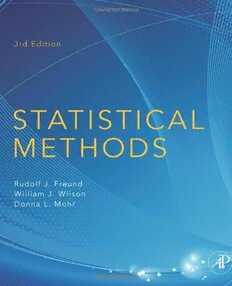
Statistical methods PDF
Preview Statistical methods
Statistical Methods Page is blank Statistical Methods Third Edition Rudolf J. Freund Texas A&M University, Emeritus William J. Wilson University of North Florida, Emeritus Donna L. Mohr University of North Florida AMSTERDAM(cid:129)BOSTON(cid:129)HEIDELBERG(cid:129)LONDON NEWYORK(cid:129)OXFORD(cid:129)PARIS(cid:129)SANDIEGO SANFRANCISCO(cid:129)SINGAPORE(cid:129)SYDNEY(cid:129)TOKYO AcademicPressisanimprintofElsevier AcademicPressisanimprintofElsevier 30CorporateDrive,Suite400,Burlington,MA01803,USA 525BStreet,Suite1900,SanDiego,California92101-4495,USA 84Theobald’sRoad,LondonWC1X8RR,UK Copyright©2010ElsevierInc.Allrightsreserved. Nopartofthispublicationmaybereproducedortransmittedinanyformorbyanymeans,electronicormechanical, includingphotocopying,recording,oranyinformationstorageandretrievalsystem,withoutpermissioninwritingfromthe publisher.Detailsonhowtoseekpermission,furtherinformationaboutthePublisher’spermissionspoliciesandour arrangementswithorganizationssuchastheCopyrightClearanceCenterandtheCopyrightLicensingAgency,canbe foundatourwebsite:www.elsevier.com/permissions. ThisbookandtheindividualcontributionscontainedinitareprotectedundercopyrightbythePublisher (otherthanasmaybenotedherein). Notices Knowledgeandbestpracticeinthisfieldareconstantlychanging.Asnewresearchandexperiencebroadenour understanding,changesinresearchmethods,professionalpractices,ormedicaltreatmentmaybecomenecessary. Practitionersandresearchersmustalwaysrelyontheirownexperienceandknowledgeinevaluatingandusingany information,methods,compounds,orexperimentsdescribedherein.Inusingsuchinformationormethodstheyshouldbe mindfuloftheirownsafetyandthesafetyofothers,includingpartiesforwhomtheyhaveaprofessionalresponsibility. Tothefullestextentofthelaw,neitherthePublishernortheauthors,contributors,oreditors,assumeanyliabilityforany injuryand/ordamagetopersonsorpropertyasamatterofproductsliability,negligenceorotherwise,orfromanyuseor operationofanymethods,products,instructions,orideascontainedinthematerialherein. LibraryofCongressCataloging-in-PublicationData Freund,RudolfJakob,1927- Statisticalmethods/RudolfJ.Freund,WilliamJ.Wilson,DonnaL.Mohr.–3rded. p.cm. Includesbibliographicalreferencesandindex. ISBN978-0-12-374970-3(hardcover:alk.paper)1.Statistics.I.Wilson,WilliamJ. II.Mohr,DonnaL.III.Title. QA276.12.F752010 519.5–dc22 2010016883 BritishLibraryCataloguing-in-PublicationData AcataloguerecordforthisbookisavailablefromtheBritishLibrary. ISBN:978-0-12-374970-3 ForinformationonallAcademicPresspublications visitourWebsiteatwww.elsevierdirect.com PrintedinCanada 10 11 12 13 9 8 7 6 5 4 3 2 1 Preface ThegoalofStatisticalMethods,ThirdEdition,istointroducethestudentbothtostatis- ticalreasoningandtothemostcommonlyusedstatisticaltechniques.Itisdesigned forundergraduatesinstatistics,engineering,thequantitativesciences,ormathemat- ics;orforgraduatestudentsinawiderangeofdisciplinesrequiringstatisticalanalysis ofdata.Thetext canbe coveredinatwo-semester sequence,withthefirstsemester correspondingtothefoundationalideasinChapters1through7andperhapsChap- ter 12. Throughout the text, techniques have almost universal applicability. They maybeillustratedwithexamplesfromagricultureoreducation,buttheapplications couldjusthaveeasilyoccurredinpublicadministrationorengineering. Ourambitionisthatstudentswhomasterthismaterialwillbeabletoselect,imple- ment,andinterpretthemostcommontypesofanalysesastheyundertakeresearch in their own disciplines. They should be able to readresearch articles and in most casesunderstandthedescriptionsofthestatisticalresultsandhowtheauthorsused them to reach their conclusions. They should understand the pitfalls of collecting statisticaldata,andtherolesplayedbythevariousmathematicalassumptions. Statisticscanbestudiedatseverallevels.Ononehand,studentscanlearnbyrotehow toplugnumbersintoformulas,ormoreoftennow,intoacomputerprogram,and drawanumberwithaneatcirclearoundit astheanswer.Thislimited approachis mind-numbing,andrarelyleadstothekindofunderstandingthatallowsstudentsto criticallyselectmethodsandinterpretresults.Ontheotherhand,therearenumerous textbooksthatprovideintroductionstotheelegantmathematicalbackgroundsofthe methods.Althoughthisisamuchdeeperunderstandingthanthefirstapproach,its prerequisitemathematicalunderstandingclosesittopractitionersfrommanyother disciplines. In this text, we have tried to take a middle way. We present enough of the formu- las tomotivatethetechniques,andillustrate theirnumericalapplicationinasmall example. However,thefocusofthediscussionisontheselection ofthetechnique, theinterpretationoftheresults,andacritiqueofthevalidityoftheanalysis.Weurge thestudent(andinstructor)tofocusontheseskills. xvii xviii Preface GUIDING PRINCIPLES ■ Nomathematicsbeyondalgebraisrequired.However,mathematicallyoriented studentsmaystillfindthematerialinthisbookchallenging,especiallyifthey alsoparticipateincoursesinstatisticaltheory. ■ Formulasarepresentedprimarilytoshowthehowandwhyofaparticular statisticalanalysis.Forthatreason,thereareaminimalnumberofexercisesthat plugnumbersintoformulas. ■ Allexamplesareworkedtoalogicalconclusion,includinginterpretationof results.Wherecomputerprintoutsareused,resultsarediscussedandexplained. Ingeneral,theemphasisisonconclusionsratherthanmechanics. ■ Throughoutthebookwestressthatcertainassumptionsaboutthedatamustbe fulfilledinorderforthestatisticalanalysestobevalid,andweemphasizethat althoughtheassumptionsareoftenfulfilled,theyshouldberoutinelychecked. NEW TO THIS EDITION ■ Strongerlinktoresearchliteratureinotherfields.Wehaveaddedcasestudies, examples,andexercisesthatcitearticlesinotherdisciplinesandinvitethe studentstodrawparallelswiththechapter’ssubjectmatter. ■ Examplesofcontemporary topics.WehaveaddedinformationonPoisson regression,randomizationtests,andthebootstrap,asthesetechniquesare becomingmoreroutine. ■ Examplesoftopicsinstatisticalfoundations.Wehaveaddedabriefdescriptionof theterminologyofmaximumlikelihoodandonthepropertiesoflinear combinationsofregressionparameters. ■ Earlyintroductiontoissuesinsampling.Wehaveeliminatedthebriefchapteron samplingthatcameattheendoftheSecondEditiontomakeroomforother topics.However,wehaveaddedasectioninChapter1thatshouldintroduce studentstotheimportanceofrandomsampling,andtothedangersof conveniencesamplesandnonresponse. ■ Expandedexercises.Wehaveaddedover100newquestionsandexercises. ■ Projects.Wehaveaddedopen-endedprojectstomostchapters,givingstudentsa chancetoworkwithdatasetsofreasonablesizeandcomplexity. USING THIS BOOK Organization TheorganizationofStatisticalMethods,ThirdEdition,followstheclassicalorder.The formulas in the book are generally the so-called definitional ones that emphasize conceptsratherthancomputationalefficiency.Theseformulascanbeusedforafew oftheverysimplestexamplesandproblems,butweexpectthatvirtuallyallexercises will be implemented on computers. The first seven chapters, which are normally Preface xix covered in a first semester, include data description, probability andsampling dis- tributions, the basics of inference for one and two sample problems, the analysis ofvariance,andone-variableregression.Thesecondportionofthebookstartswith chaptersonmultipleregression,factorialexperiments,experimentaldesign,andan introductiontogenerallinearmodelsincludingtheanalysisofcovariance.Wehave separatedfactorialexperimentsanddesignofexperimentsbecausetheyaredifferent applicationsofthesamenumericmethods. The last three chapters introduce topics in the analysis of categorical data, logistic and other special types of regression, and nonparametricstatistics. These chapters provideabriefintroductiontotheseimportanttopicsandareintendedtoroundout thestatisticaleducationofthosewhowilllearnfromthisbook. Coverage Thisbookcontainsmorematerialthancanbecoveredinatwo-semestercourse.We havepurposelydonethisfortworeasons: ■ Becauseofthewidevarietyofaudiencesforstatisticalmethods,notall instructorswillwanttocoverthesamematerial.Forexample,courseswith heavyenrollmentsofstudentsfromthesocialandbehavioralscienceswillwant toemphasizenonparametricmethodsandtheanalysisofcategoricaldatawith lessemphasisonexperimentaldesign. ■ Studentswhohavetakenstatisticalmethodscoursestendtokeeptheirstatistics booksforfuturereference.Werecognizethatnosinglebookwilleverserveasa completereference,butwehopethatthebroadcoverageinthisbookwillat leastleadthesestudentsintheproperdirectionwhentheoccasiondemands. Sequencing For the most part, topics are arranged so that each new topic builds on previous topics,hencecoursesequencingshouldfollowthebook.Thereare,however,some exceptionsthatmayappealtosomeinstructors: ■ Insomecasesitmaybepreferabletopresentthematerialoncategoricaldataat anearlystage.MuchofthematerialinChapter12(CategoricalData)canbe taughtanytimeafterChapter5(InferenceforTwoPopulations). ■ Someinstructorsprefertopresentnonparametricmethodsalongwith parametricmethods.Again,anyofthesectionsinChapter14(Nonparametric Methods)maybeextractedandpresentedalongwiththeiranalogous parametrictopicinearlierchapters. Exercises Properly assigned and executed exercises are an integral part of any course in sta- tistical methods.We have placedall exercises at the endsof chapterstoemphasize problem solving (including the identification of an appropriate technique) rather xx Preface thanmechanics.Thisplacementmayhavetheunintendedconsequencethatstudents delay starting these problems until the chapters have been completed, resulting in unevenworkloads.Toalleviate thispotentialproblem,wehaveplacedinstructions oninitiatingworkonexercisesthroughoutsomeofthelongerchapters.Studentsare alsoencouragedtoworkthroughallexamples. Wehavedeliberatelyleftsignificancelevels unspecifiedintheprojectsandinsome exercises.Instructorsarefreetoissuegeneralinstructionsregardingadefaultsignifi- cancelevel,orcanencouragestudentstodiscussanappropriatechoiceaspartofthe problemsolution. Most chapters also include one or more project descriptions. These are generally open-endedquestionsaddressingoneofthedatasetsdescribedinAppendixC.These projectsgivestudentsthechancetotrytheirhandatsmallreports,completewithan appropriate selection of graphs and tables. Whether the instructor uses these data setsorfindsotherexamples,thesetypesofassignmentsareperhapsthebestlearning experiencesthatstudentscanhave. Data files for all exercises and examples are available from the text Web site at http://www.elsevierdirect.cominASCII(txt),EXCEL,andSASformat. Computing It isessential thatstudents haveaccessto statistical software.All themethodsused inthistextarecommonenoughsothatanymultipurposestatisticalsoftwareshould suffice.(The singleexception is thebootstrap,at theveryendof thetext.)Forcon- sistency and convenience, and because it is the most widely used single statistical computingpackage,wehavereliedheavilyontheSASSystemtoillustrateexamples inthistext.However,westressthattheexamplesandexercisescouldaseasilyhave beendoneinSPSS,Stata,R,Minitab,oranyofanumberofothersoftwarepackages. As we demonstrate in a few cases, the various printouts contain enough common informationthat,withtheaidofdocumentation,someonewhocaninterpretresults fromonepackageshouldbeabletodosofromanyother. ThistextdoesnotattempttoteachSASoranyotherstatisticalsoftware.Genericrather thansoftware-specific instructionsare the onlydirections given forperformingthe analyses. Most common statistical software has an increasing amount of indepen- dently published material available, either in traditional printor online.Forthose who wish to use the SAS System, sample programs for the examples within each chapterhave been provided on the text Web site at http://www.elsevierdirect.com. Students may find these of use as template programs that they can adapt for the exercises. ACKNOWLEDGMENTS We would like to thankthe Department of Statistics of Texas A&M University and theDepartmentofMathematicsandStatisticsoftheUniversityofNorthFloridafor thecooperationandencouragementthatmadethisbookpossible. We are grateful to the staff at Elsevier, Inc. who made the third edition possible, particularlyPatriciaOsborn,AcquisitionsEditor,GavinBecker,AssistantEditor,and DawnmarieSimpson,ProjectManager.We thankthereviewers,whoseusefulcom- mentsgaveusgreatguidance:BroderickOluyede,GeorgiaSouthernUniversity,and Brian Habing, University of South Carolina. We thank Kelly Jones, University of NorthFlorida,forherassistanceinpreparingthesolutionsandonlinedatasets. We acknowledgeMinitab Inc.,SASInstitute, SPSSInc.,andMicrosoft Corporation whosesoftware(Minitab,theSASSystem,SPSS,andExcel,respectively)areusedto illustratethecomputerprintouts.TheSASSystemwasusedtocomputethetablesfor thenormal,t,χ2,andF distributions.WealsogratefullyacknowledgetheBiometric Society, the Trustees of Biometrika, Journal of Quality Technology, and American CyanamidCompanyfortheirpermissiontoreproducetablespublishedundertheir auspices. We thanktheorganizersofFloridaLakewatchfortheirpermissiontouse dataasasourcefornumerousassignments. Finally, we owe an undying debt of gratitude to our spouses, Marge, Marilyn, and Jonathan,whohave encouragedourcontinuingthis projectdespite the often- encounteredfrustrations. For access to the datasets and additional materials on the student’s companion site, pleasevisithttp://www.elsevierdirect.com. xxi CHAPTER 1 Data and Statistics CONTENTS 1.1 Introduction............................................................................. 1 1.2 Observations and Variables....................................................... 6 1.3 TypesofMeasurements forVariables ......................................... 10 1.4 Distributions............................................................................ 12 1.5 NumericalDescriptive Statistics................................................. 19 1.6 ExploratoryData Analysis ......................................................... 32 1.7 Bivariate Data.......................................................................... 39 1.8 Populations, Samples,andStatistical Inference—APreview......... 43 1.9 DataCollection......................................................................... 44 1.10 Chapter Summary..................................................................... 46 1.11 Chapter Exercises .................................................................... 51 1.1 INTRODUCTION To most people the word statistics conjuresup images of vast tables of confusing numbers,volumesandvolumesoffigurespertainingtobirths,deaths,taxes,popula- tions,andsoforth,orfiguresindicatingbaseballbattingaveragesorfootballyardage gained flashing across television screens. This is so because in common usage the wordstatisticsissynonymouswiththeworddata.Inasensethisisareasonablyaccu- rate impressionbecausethediscipline ofstatistics deals largelywithprinciplesand proceduresforcollecting,describing,anddrawingconclusionsfromdata.Therefore StatisticalMethods,DOI:10.1016/B978-0-12-374970-3.00001-9 1 ©2010,ElsevierInc.Allrightsreserved.
